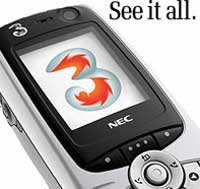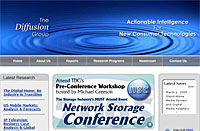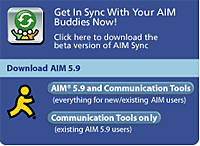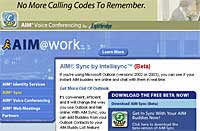More than 400 industry professionals gathered for Digital Media Wire’s 5th annual Digital Music Forum at The French Institute in New York City on Wednesday. Discussion topics recalled the creation of the original Napster, examined the current business and legal environment, and looked ahead optimistically towards the future growth of subscription and mobile services.
In a widely anticipated keynote conversation, Napster founder Shawn Fanning described how early peer-to-peer file trading networks fundamentally changed consumer expectations for the breadth of music content available to them. Speaking about his new venture, Snocap, Fanning outlined his plans to create a central database for rights clearance while introducing a digital identification and acoustic fingerprinting architecture for file trading systems. Fanning expressed his hope that the creation of a trusted third party to manage rights administration will create an environment in which the interests of peer-to-peer companies, retailers, and content owners will not be in conflict.
Technology and rights management remained in the spotlight during a panel discussion about the forthcoming MGM v. Grokster case that will go before the Supreme Court on March 29th. At issue, according to Digital Media Association Executive Director Jonathan Potter, is whether a software developer can be held liable for the actions of its users. Martin Elgison, a partner at Alston & Bird, advocated separate assessments of legality for a company’s business conduct and the associated technology. Jim Delong, senior fellow at The Progress & Freedom Foundation, agreed that the courts need to examine a company’s underlying business model and question whether it depends on copyright infringement.
Speaking to technology’s current effects on artist management, Nettwerk Productions CEO Terry McBride conveyed that digitization currently represents a mixed opportunity for his clients like Avril Lavigne, Sarah McLachlan and Barenaked Ladies. On the one hand, McBride reported, Barenaked Ladies sold more than 900,000 live tracks in the past year and archives 150 concerts for sale online. On the other, he voiced concern that his artists’ catalog sales are being negatively affected by peer-to-peer file trading. On the whole, McBride was bullish on technology’s long-term potential, both for management companies seeking to provide for all their clients’ needs, as well as for artists pursuing long term careers.
In an afternoon keynote, Yahoo Music Vice President and General Manager David Goldberg highlighted the opportunities created by consumers’ desires to discover and control their music in an on-demand environment. Goldberg predicted the continued emergence of subscription-based digital music services, as well as the use of customization and community functionality to drive traffic and consumer engagement. According to Goldberg, playlists will become the “killer app of music” for users confronted with more than a million tracks at their fingertips and services will need to focus on delivering appropriate recommendations to create the ultimate listening experience.
MSN Marketplaces General Manager Mike Conte addressed Microsoft’s digital music effort which initially launched last October as an a-la-carte download service. According to Conte, Microsoft is principally involved with music to drive traffic and advertisers to MSN.com while contributing to the company’s strategy to build an overall ecosystem for digital media. While emphasizing that Microsoft’s plans were still in their early stages, Conte echoed Goldberg in emphasizing the importance of building community to engage customers and alluded to future digital music integration with messaging, blogging and playlist capabilities. Conte also agreed with predictions for the future growth of subscription services, citing company research indicating that the younger the consumer, the lower the likelihood that they desire to own their music.
During morning and afternoon panels, participants painted a positive future for the mobile music marketplace. Sony BMG Senior Vice President Thomas Gewecke noted that mobile services continue to be the dominant digital revenue stream outside the United States. Gewecke further predicted that mobile devices will become the dominant method for initial music purchases, even if the content is eventually consumed on another platform. Sprint General Manager of Wireless Music and Personalization Nancy Beaton reported that music represents an important way for the company to boost its current average monthly bill of $62. Beaton also cited successful ringtone launches with artists like Beyonce and 50 Cent, with both reaching platinum sales levels.
Thanks to Wesley Radez (wradez @ digitalmusicnews.com) over at Digital Music News for this report.
 After a shaky start, the 3G bandwagon is finally starting to roll with 20 million 3G phones sold last year and shedloads of new funky, feature-packed phones on the way.
After a shaky start, the 3G bandwagon is finally starting to roll with 20 million 3G phones sold last year and shedloads of new funky, feature-packed phones on the way. “We’re very much at the foothills regarding content on mobiles,” says Price. “Now we’re going to have to be a bit more experimental and different. The network owners are looking for something that pushes the boundaries a bit more and gives them more of a reason to develop content off the back of existing [brands] or to think about commissioning new content.”
“We’re very much at the foothills regarding content on mobiles,” says Price. “Now we’re going to have to be a bit more experimental and different. The network owners are looking for something that pushes the boundaries a bit more and gives them more of a reason to develop content off the back of existing [brands] or to think about commissioning new content.” Right now, they’re not interested in arty-farty experimental stuff, out-there comedy or ‘genre-challenging’ downloads: they want straight down-the-line popular content that will shift phones and entice new subscribers by the bucketload.
Right now, they’re not interested in arty-farty experimental stuff, out-there comedy or ‘genre-challenging’ downloads: they want straight down-the-line popular content that will shift phones and entice new subscribers by the bucketload. The end result is a predictable but unit-shifting fare of footie, ringtones, horoscopes, weather and the like.
The end result is a predictable but unit-shifting fare of footie, ringtones, horoscopes, weather and the like. Evidence is beginning to amass that two of the most hyped products in the early digital home market will be lucky if they manage to reach niche market status in the next few years.
Evidence is beginning to amass that two of the most hyped products in the early digital home market will be lucky if they manage to reach niche market status in the next few years. A deal between a search technology company and an online film distributor could be a further step towards the next Big Thing on the Web: search engines that let you find movies and TV episodes by what is said within them – and then buy or rent them.
A deal between a search technology company and an online film distributor could be a further step towards the next Big Thing on the Web: search engines that let you find movies and TV episodes by what is said within them – and then buy or rent them. With TV networks starting to distribute more of their productions on the Web and the growth of broadband-enabled, home media PCs there’s clearly a growing demand for consumers to be able to access and download content legally.
With TV networks starting to distribute more of their productions on the Web and the growth of broadband-enabled, home media PCs there’s clearly a growing demand for consumers to be able to access and download content legally. When Sony start slapping the world famous Walkman mobile music brand on their products, you know that they mean business, and their new Sony Ericsson W800 has been proudly trumpeted as the first mobile phone to combine a high-quality digital music player and a 2 Megapixel camera.
When Sony start slapping the world famous Walkman mobile music brand on their products, you know that they mean business, and their new Sony Ericsson W800 has been proudly trumpeted as the first mobile phone to combine a high-quality digital music player and a 2 Megapixel camera. Sadly, we’re going to have to wait a while before we can start adjusting our lifestyle behaviour – the release of the Sony Ericsson W800 is not scheduled until the third quarter of 2005
Sadly, we’re going to have to wait a while before we can start adjusting our lifestyle behaviour – the release of the Sony Ericsson W800 is not scheduled until the third quarter of 2005 America Online has announced plans to enable users of its instant messaging service (AIM) to see when friends and business associates are online, even if they’re not on the contact list.
America Online has announced plans to enable users of its instant messaging service (AIM) to see when friends and business associates are online, even if they’re not on the contact list. AOL has also announced a relationship with CareerBuilder.com to bring together recruiters and online job applicants. A prospective employer, who spots a job seeker’s résumé with an AIM address, can instantly send a message to that person in real time.
AOL has also announced a relationship with CareerBuilder.com to bring together recruiters and online job applicants. A prospective employer, who spots a job seeker’s résumé with an AIM address, can instantly send a message to that person in real time. Destiny Media Technologies has announced a new version of its proprietary anti-piracy and digital distribution system, Promo Only MPE 1.1, designed to secure electronic music distribution within the music industry.
Destiny Media Technologies has announced a new version of its proprietary anti-piracy and digital distribution system, Promo Only MPE 1.1, designed to secure electronic music distribution within the music industry. “The new build was modified with the customers’ ease of use in mind,” gushed Dean Ernst, Director of the MPE project at Promo Only. “The response to version 1.1 has been unprecedented and reflective of the overwhelming number of users signed-on to date.”
“The new build was modified with the customers’ ease of use in mind,” gushed Dean Ernst, Director of the MPE project at Promo Only. “The response to version 1.1 has been unprecedented and reflective of the overwhelming number of users signed-on to date.” Jens of Sweden has unveiled its latest cool digital music player which they reckon will give iPod Shuffle a run for its money.
Jens of Sweden has unveiled its latest cool digital music player which they reckon will give iPod Shuffle a run for its money. Apple has updated its iPod photo line-up with a new slim 30GB model, holding up to 7,500 songs, for just £249 ($475, e360) and a new 60GB model, holding up to 15,000 songs, for £309 ($590, e446)
Apple has updated its iPod photo line-up with a new slim 30GB model, holding up to 7,500 songs, for just £249 ($475, e360) and a new 60GB model, holding up to 15,000 songs, for £309 ($590, e446) The truth is that the iPod photo seems to be far better as a versatile MP3 player and photo presentation unit rather than something for serious photographers to use for direct-to-camera storage.
The truth is that the iPod photo seems to be far better as a versatile MP3 player and photo presentation unit rather than something for serious photographers to use for direct-to-camera storage. A handy Google search feature went live this week that lets users find showtimes at nearby movie theatres using either their computer or mobile phones and other wireless devices that use short-message services.
A handy Google search feature went live this week that lets users find showtimes at nearby movie theatres using either their computer or mobile phones and other wireless devices that use short-message services.